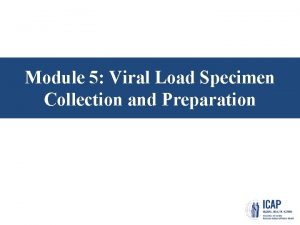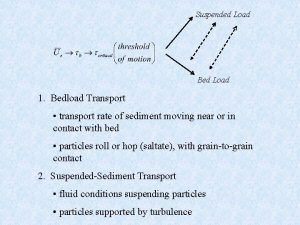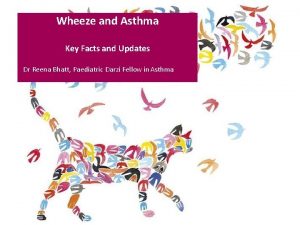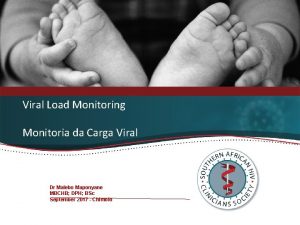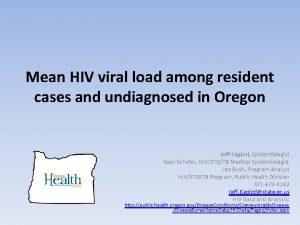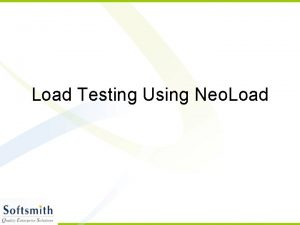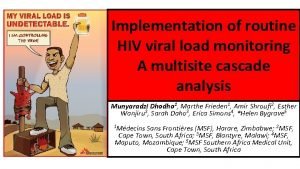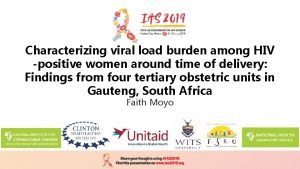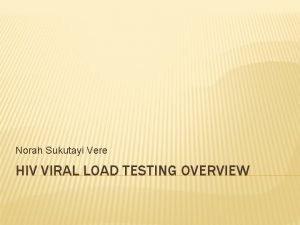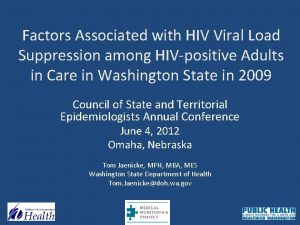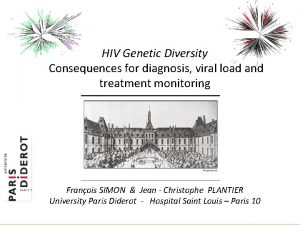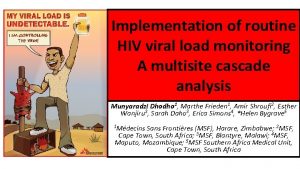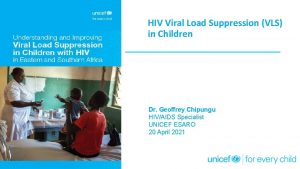Population Viral Load Measures and A Recent HIV











![Viral Load Measures Mean Std. Err. [95% CI] Mean log 10 VL of those Viral Load Measures Mean Std. Err. [95% CI] Mean log 10 VL of those](https://slidetodoc.com/presentation_image_h/9e6db8e2632a7413e291e2d2c23d00e0/image-12.jpg)





- Slides: 17

Population Viral Load Measures and A Recent HIV Case at Enumeration Area Level Farahani 1, M. , Radin 1, E. , Saito 1, S. , Sachathep 1, K. , Manjengwa 1, J. , Balachandra 2, S. , Low 1, A. , Duong 1, Y. , Jonnalagadda 2, S. , Patel 2, H. , Voetsch 2, A. , Hladik 2, W. , Hakim 2, A. , Ahmed 1, N. , Musuka 1, G. , Tippett Barr 2, B. , Wadonda-Kabondo 2, N. W. , Auld 2, A. , Jahn 2, A. , Williams 2, D. , Barradas 2, D. , Payne 2, D. , Bello 3, G. , Mugurungi 4, O. , Parekh 2, B. , Hoos 1, D. , Justman 1, J. 1: ICAP at Columbia University; 2: U. S. Centers for Disease Control and Prevention (CDC); 3: ITECH-Malawi; 4: Zimbabwe Ministry of Health and Child Care

UNAIDS Goal and Targets Goal: To end the AIDS epidemic by 2030. Targets: by 2020 More PLHIV on ART Lower plasma VL Lower HIV incidence

Encouraging Results Towards 90 -90 -90 • Encouraging initial findings from the Population-based HIV Impact Assessment (PHIA) surveys in 9 countries. • VLS among those on ART range from 75. 9 in Cote d’Ivoire to 91. 9% in e. Swatini (Swaziland).

Concerns for Internal Validity in Early Studies • Many studies used different measures of aggregate VL to evaluate the ART programs and as a proxy for HIV incidence since 2009 • Limitations and biases in previous studies: – Ecological fallacy – Sampling bias – Missing data – Not including HIV prevalence in the model – Only those with a known HIV status were included Miller, W. C. , et al (2013). "Community viral load as a measure for assessment of HIV treatment as prevention. " The Lancet Infectious Diseases 13 (5): 459 -464

Concerns for External Validity in Recent Studies • Recent studies showed population VL and prevalence of viremia are correlated with HIV incidence • Hard to extrapolate to the general population: – Certain locations (Rural Kwa. Zulu-Natal, South Africa; 22 cities in India) – Populations (PWID and MSM) Solomon, S. S. , et al (2016). "Community viral load, antiretroviral therapy coverage, and HIV incidence in India: a cross-sectional, comparative study. " The Lancet HIV 3(4): e 183 -e 190. Tanser, F. , et al (2017). "Effect of population viral load on prospective HIV incidence in a hyperendemic rural African community. " Science translational medicine 9(420): eaam 8012.

Research question • Is there an association between population viral load and viral load suppression and the probability of at least one recent HIV 1 infection in the surveys’ smallest geographic sampling unit (an enumeration area)?

Methods • Nationally representative, crosssectional data from PHIA surveys in Zimbabwe, Malawi, and Zambia. • Two-stage stratified cluster sample, – 1 st : EAs from the latest census – 2 nd : randomly selected a sample of households in each EA Graphic compliment to UN Statistics Division

Enumeration Area Sample Size Total data collected: 1, 510 EAs across the three surveys Included in this study: 1, 374 EAs (91%) with at least one HIV+ adult, consenting to an interview and blood draw. Zimbabwe Malawi Zambia Urban 155 160 194 Rural 344 340 317 Total of 58, 366 adults aged 15 -59 years Total 499 500 511

Number of recent cases Number of recent HIV cases at EAs Malawi Zambia Zimbabwe Total 0 405 (93. 5%) 406 (90. 6%) 463 (94. 1%) 1, 274 (92. 8%) 1 27 (6. 2%) 40 (8. 9%) 27 (5. 5%) 94 (6. 9%) 2 1 (0. 2%) 2 (0. 5%) 2 (0. 4%) 5 (0. 4%) Total 433 448 492 1, 373

Definitions of Viral Load Aggregate Measures • Population VL: the arithmetic mean of log 10 VL in all PLHIV in the EA, irrespective of whether they were aware of HIV status • Unaware VL: the arithmetic mean of log 10 VL in individuals with HIV in an EA unaware of their HIV status • In-care VL: the arithmetic mean of log 10 VL of all HIV-positive persons in -care • Prevalence of viremia: the prevalence of individuals with HIV in the EA with HIV RNA >1000 c/m. L.

Summary Statistics Median (IQR) Median age of the female population at the EA 31. 0 (29 -33) Median age of the male population at the EA 30. 7 (29 -33) Proportion of people ever tested HIV at the EA 77% (71 -82) HIV prevalence at the EA 14% (9 -20) Prevalence of awareness of HIV status among PLHIV 75% (57 -91) ART coverage among PLHIV 67% (50 -72) Prevalence of VLS among PLHIV 67% (50 -83)
![Viral Load Measures Mean Std Err 95 CI Mean log 10 VL of those Viral Load Measures Mean Std. Err. [95% CI] Mean log 10 VL of those](https://slidetodoc.com/presentation_image_h/9e6db8e2632a7413e291e2d2c23d00e0/image-12.jpg)
Viral Load Measures Mean Std. Err. [95% CI] Mean log 10 VL of those on ART 0. 66 0. 03 0. 61 - 0. 71 Mean log 10 VL of those unaware of HIV status 2. 66 0. 06 2. 43 – 2. 69 Mean log 10 Population VL 1. 88 0. 04 1. 79 – 1. 97 Prevalence of viremia > 1000 c/m. L 36% 0. 06 35 - 37

Correlation Between PVL/Unaware VL and A Recent HIV Case

Correlation Between 90 -90 -90 Indicators and A Recent HIV Case

Interpretation • Half a log higher in the mean log of PVL increases the predicted probability of having a new HIV case by 13% • When prevalence of VLS rises from 40% to 60%, the predicted probability of new HIV infection at enumeration area level drops by 26%.

Conclusion • We found a strong association between PVL and VLS prevalence with recent HIV-1 infection at the EA level in three southern African countries with generalized HIV epidemics. • These results suggest expanding and maintaining high levels of VLS may be key to HIV epidemic control in these three countries.

Acknowledgements Suzue Saito CDC - Malawi Kristin Brown Andrea Low Andrew Auld Melissa Cates Stephen Delgado Geoffrey Chipungu Mervi Detorrio Elizabeth Gummerson Evelyn Kim Trudy Dobbs Karam Sachathep Danielle Payne Linda Fleming Neena Philip Nellie Wadonda-Kabondo Avi Hakim Jill Pace Christine West Wolfgang Hladik Rita Sondengam Keisha Jackson Natasha Mc. Leod CDC-Zimbabwe Sasi Jonnalagadda Noelle Esquire Beth Barr Steven Kinchen Sally Findley Elizabeth Gonese Kathryn Lupoli Josh Krieger Amy Herman-Roloff Stephen Mc. Cracken Olga Crowley Evonne (Amaka) Nwankwo. Carin Molchan Yen Pottinger Igomu Carole Moore Katie Johnson Sheetal Patel Christopher Murrill Stephen Arpadi Leala Ruangtragool Katina Pappas-Deluca Joseph Elias Norah Sukutayi Vere Bharat Parekh Chelsea Solmo Jacqueline Rurangirwa Natazia Fistrovic CDC-Zambia Tonya Ross Walker Nahima Ahmed Danielle Barradas Vedapuri Shanmugam Kiwon Lee Haotian Cai Katrina Sleeman Hannah Chung Sarah Guagliardo Paul Stupp Melissa Metz Sundeep Gupta Daniel Williams Rachel Bray Kathy Hageman Floris Wray-Gordon Michael Cooney Stanley Kamocha Daniel Yavo Lauren Williams Clement Ndongmo Ernest Yufenyuy Margaret Riggs Janet Burnet ICAP in Zimbabwe Godfrey Musuka CDC-Atlanta ICAP – New York Givemore Chundu Arnesler Coleman Mark Fussell Hazel Dube Sehin Birhanu Elizabeth Radin Julius Manjengwa Desmond Mamini Rosemary Muchengeti Vusumuzi Maliwa ICAP in Zambia Kumbutso Dzekedzeke Darius Simbeye Casco Mubanga Mulenga Katongo Tepa Nkumbula Robyn London Martin Katongo James Shamamba Theresa Sikateyo ICAP in Malawi Stephen Nkoka Christine Chung Huxley Kanyongoloka Sungani Zidana-Ndovi Khozgani Mzumara Richard Mmanga Helecks Mtengo South Africa Regional Office Blanche Pitt Charles Wentzel Bright Phiri Herbert Longwe Takura Kupamupindi Belete Tegbaru Erkyhun Pule Mphohle Oliver Murangandi Government of Zimbabwe Ministry of Health and Child Care Owen Mugurungi Gibson Mhlannga Mutsa Mhangara Tsitsi Apollo Agnes Mushavi Getrude Ncube National AIDS Council ( Zimbabwe) Tapuwa Magure Amon Mpofu Ministry of Health, Zambia Chipalo Kaliki Crispin Moyo National Statistics Office (NSO), Malawi J. Ndawala National AIDS Commission, Malawi Blackson Matatiyo ZIMSTAT Godfrey Matsinde Aluwisio Mukavhi Nyaradzai Ngonyama Langton Chikeya University of Zambia Emmanuel Tembo Jacob Malungo Nkuye Moyo Ministry of Health, Malawi BRTI Frank Chimbwandira Peter Mason George F. Bello Shungu Munyati Andreas Jahn Lovemore Gwanzura Sikhona Chipeta Salome Manyau Mathews Kagoli C. Mwansambo Lancet Zimbabwe Sheila Bandazi Charles Muronda D. Kabambe Grace Ramhewa R. Mwenda Central Statistical Office, Blantyre Health Research and Zambia Training Trust (BHRTT)-Johns Nchimunya Nkombo Hopkins University Iven SIkanyiti Laboratories Chola Nakazwe Daka N. Kumwenda Palver Sikanyiti Elizabeth Kampira Chibesa Musamba Centre for Social Research, Tropical Diseases Research Malawi Centre, Zambia A. Munthali Webster Kasongo John Kadzandira University Teaching Hospital, Zambia Gina Mulundu This project is supported by the U. S. President’s Emergency Plan for AIDS Relief (PEPFAR) through CDC under the terms of cooperative agreement #U 2 GGH 001226. The contents are the responsibility of ICAP and do not necessarily reflect the views of the United States Government. The mark "CDC" is owned by the US Dept. of Health and Human Services and is used with permission. Use of this logo is not an endorsement by HHS or CDC of any particular product, service, or enterprise.
 When blood sample hemolyzed
When blood sample hemolyzed Thrust load bearing
Thrust load bearing Tributary load and load path
Tributary load and load path Suspended load definition
Suspended load definition Difference between ac load line and dc load line
Difference between ac load line and dc load line Repeated-measures design
Repeated-measures design Section 24-1 viral structure and replication
Section 24-1 viral structure and replication Section 1 population dynamics answer key
Section 1 population dynamics answer key Section 1 population dynamics answer key
Section 1 population dynamics answer key Population ecology section 1 population dynamics
Population ecology section 1 population dynamics Population ecology chapter 4 answers
Population ecology chapter 4 answers Aerochamber definition
Aerochamber definition Vrus
Vrus Inklüzyon cisimcikleri
Inklüzyon cisimcikleri Egg inoculation diagram
Egg inoculation diagram Viral inoculation in embryonated egg
Viral inoculation in embryonated egg Virus cultivation in embryonated eggs
Virus cultivation in embryonated eggs Spasmodic croup vs viral croup
Spasmodic croup vs viral croup
